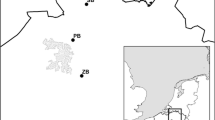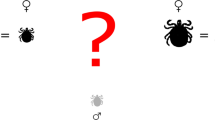Summary
This study examined whether the mating or feeding success of females of two tick species, Amblyomma limbatum and Aponomma hydrosauri, is influenced by their site of attachment on a host. Marked interspecific differences were detected in the preferred sites of attachment of females to their common host, the sleepy lizard Tiliqua rugosa, with Amb. limbatum found predominantly in the ears and on the lower back, while Ap. hydrosauri preferred to attach under the forelimbs and on the midback. Data from field surveys suggested that higher proportions of females were mated in the preferred sites for Ap. hydrosauri, and in one of the preferred sites for Amb. limbatum. However, laboratory and field experiments showed that for both species, the mean time before females were mated, mean engorgement time and mean feeding rate were independent of where they were attached to a host. Four hypotheses were considered as explanations of the observed niche segregation; intespecific competition, avoidance of pheromone jamming or adaptations, to maximize mating and feeding, and minimize physical disturbance. These could not totally explain the observed site specificity in either tick species. Site specificity may represent adaptations by each species to other host species encountered within their distributional range.
Similar content being viewed by others
References
Andrews RH (1981) The mating behaviour of three parapatric species of reptile tick. Unpublished PhD Thesis, Flinders University of South Australia
Andrews RH, Bull CM (1980) Mating behaviour in the Australian reptile tick, Aponomma hydrosauri. Anim Behav 28:1280–1286
Andrews RH, Petney TN (1981) Competition for sites of attachment to hosts in three parapatric species of reptile tick. Oecologia 51:227–232
Andrews RH, Petney TN, Bull CM (1982) Niche changes between parasite populations: An example from ticks on reptiles. Oecologia 55:77–80
Bauwens D, Strijbosch H, Stumpel AHP (1983) The lizards Lacterta agilis and L. vivipara as hosts to larvae and nymphs of the tick Ixodes ricinus. Holarctic Ecol 6:32–40
Bull CM (1987) A population study of the viviparous Australian lizard, Trachydosaurus rugosus. Behav Ecol Sociobiol 23:45–49
Bull CM (1991) Ecology of parapatric distributions. Annu Rev Ecol Syst 22:19–36
Bull CM, Sharrad RD, Petney TN (1981) Parapatric boundaries between Australian reptile ticks. Proc Ecol Soc Aust 11:95–107
Bull CM, Burzacott D, Sharrad RD (1989) No competition for resources between two tick species at their parapatric boundary. Oecologia 79:558–562
Chilton NB (1989) Life cycle adaptations and their implications in the distribution of two parapatric species of tick. Unpublished PhD thesis, Flinders University of South Australia
Chilton NB, Andrews RH (1988) Mating behaviour and parapatry in two species of Australian reptile tick. Oecologia 75:146–152
Chilton NB, Bull CM (1991) A comparison of the reproductive parameters of females of two reptile tick species. Int J Parasitol 21:907–911
Glauert L (1961) A handbook of the lizards of Western Australia. Western Australian Naturalists Club Handbook No. 6, Perth, Australia
Hayashi F, Hasegawa M (1984) Selective parasitism of the tick Ixodes asanumai (Acarina: Ixodidae) and its influence on the host lizard Eumeces okadae in Miyake-jima, Izu Islands. Appl Entomol Zool 19:181–191
Hesse GH (1985) Interstadial competition for sites of attachment to hosts in a one-host reptile tick in Senegal. Acarologia 26:355–359
Holmes JC (1973) Site selection by parasitic helminths: interspecific interactions, site segregation, and their importance to the development of helminth communities. Can J Zool 51:333–347
Holmes JC, Price PW (1980) Parasite communities: the roles of phylogeny and ecology. Syst Zool 29:203–213
Patrick MJ (1991) Distribution of enteric helminths in Glaucomys volans L. (Sciuridae): a test for competition. Ecology 72:755–758
Petney TN, Al-Yaman F (1985) Attachment sites of the tortoise tick Hyalomma aegyptium in relation to tick density and physical condition of the host. J Parasitol 71:287–289
Petney TN, Bull CM (1984) Microhabitat selection by two reptile ticks at their parapatric boundary. Aust J Zool 9:233–239
Price PW (1980) Evolutionary biology of parasites. Princeton University Press, Princeton, New Jersey
Roberts FHS (1970) Australian Ticks. C.S.I.R.O., Melbourne
Rohde K (1979) A critical evaluation of intrinsic and extrinsic factors responsible for niche restriction in parasites. Am Nat 114:648–671
Author information
Authors and Affiliations
Rights and permissions
About this article
Cite this article
Chilton, N.B., Bull, C.M. & Andrews, R.H. Niche segregation in reptile ticks: attachment sites and reproductive success of females. Oecologia 90, 255–259 (1992). https://doi.org/10.1007/BF00317183
Received:
Accepted:
Issue Date:
DOI: https://doi.org/10.1007/BF00317183




